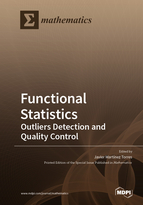Functional Statistics: Outliers Detection and Quality Control
A special issue of Mathematics (ISSN 2227-7390). This special issue belongs to the section "Engineering Mathematics".
Deadline for manuscript submissions: closed (31 October 2020) | Viewed by 25717
Special Issue Editor
Interests: functional statistics; functional outlier; quality control; process control; capability; functional data
Special Issues, Collections and Topics in MDPI journals
Special Issue Information
Dear Colleagues,
At present, a large amount of data can be approached from the functional prism and in a multitude of fields such as engineering, medicine, etc. An example of this, which is very important to the engineering (mechanical, electronic, environmental, etc.) field, is quality control, which is based on the classical Schewart methodology or WECO rules.
However, while application is important, a comparison between methods, and the design and construction of a new model, univariable or multivariable, based on depth, non-parametric, etc., is also important. Thus, in this Special Issue, different articles are collected with new models of detection of functional outliers, or applications thereof, on different areas of quality control and process capability control.
Prof. Dr. Javier Martínez Torres
Guest Editor
Manuscript Submission Information
Manuscripts should be submitted online at www.mdpi.com by registering and logging in to this website. Once you are registered, click here to go to the submission form. Manuscripts can be submitted until the deadline. All submissions that pass pre-check are peer-reviewed. Accepted papers will be published continuously in the journal (as soon as accepted) and will be listed together on the special issue website. Research articles, review articles as well as short communications are invited. For planned papers, a title and short abstract (about 100 words) can be sent to the Editorial Office for announcement on this website.
Submitted manuscripts should not have been published previously, nor be under consideration for publication elsewhere (except conference proceedings papers). All manuscripts are thoroughly refereed through a single-blind peer-review process. A guide for authors and other relevant information for submission of manuscripts is available on the Instructions for Authors page. Mathematics is an international peer-reviewed open access semimonthly journal published by MDPI.
Please visit the Instructions for Authors page before submitting a manuscript. The Article Processing Charge (APC) for publication in this open access journal is 2600 CHF (Swiss Francs). Submitted papers should be well formatted and use good English. Authors may use MDPI's English editing service prior to publication or during author revisions.
Keywords
- Functional outliers
- Functional depth
- SPC
- Capability
- Control process






